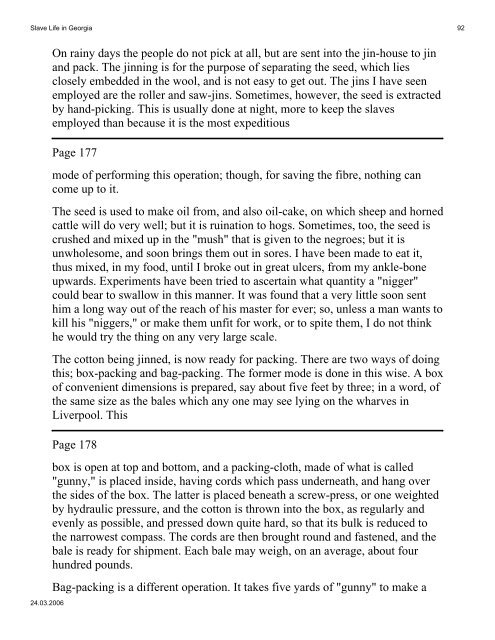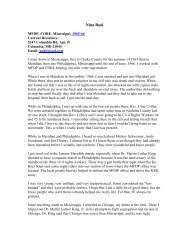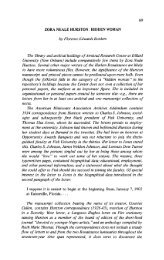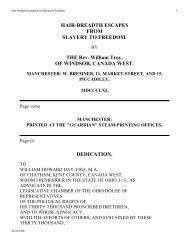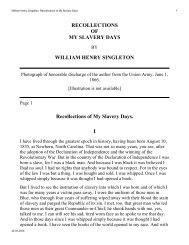Slave Life in Georgia - African American History
Slave Life in Georgia - African American History
Slave Life in Georgia - African American History
You also want an ePaper? Increase the reach of your titles
YUMPU automatically turns print PDFs into web optimized ePapers that Google loves.
<strong>Slave</strong> <strong>Life</strong> <strong>in</strong> <strong>Georgia</strong> 92<br />
24.03.2006<br />
On ra<strong>in</strong>y days the people do not pick at all, but are sent <strong>in</strong>to the j<strong>in</strong>-house to j<strong>in</strong><br />
and pack. The j<strong>in</strong>n<strong>in</strong>g is for the purpose of separat<strong>in</strong>g the seed, which lies<br />
closely embedded <strong>in</strong> the wool, and is not easy to get out. The j<strong>in</strong>s I have seen<br />
employed are the roller and saw-j<strong>in</strong>s. Sometimes, however, the seed is extracted<br />
by hand-pick<strong>in</strong>g. This is usually done at night, more to keep the slaves<br />
employed than because it is the most expeditious<br />
Page 177<br />
mode of perform<strong>in</strong>g this operation; though, for sav<strong>in</strong>g the fibre, noth<strong>in</strong>g can<br />
come up to it.<br />
The seed is used to make oil from, and also oil-cake, on which sheep and horned<br />
cattle will do very well; but it is ru<strong>in</strong>ation to hogs. Sometimes, too, the seed is<br />
crushed and mixed up <strong>in</strong> the "mush" that is given to the negroes; but it is<br />
unwholesome, and soon br<strong>in</strong>gs them out <strong>in</strong> sores. I have been made to eat it,<br />
thus mixed, <strong>in</strong> my food, until I broke out <strong>in</strong> great ulcers, from my ankle-bone<br />
upwards. Experiments have been tried to ascerta<strong>in</strong> what quantity a "nigger"<br />
could bear to swallow <strong>in</strong> this manner. It was found that a very little soon sent<br />
him a long way out of the reach of his master for ever; so, unless a man wants to<br />
kill his "niggers," or make them unfit for work, or to spite them, I do not th<strong>in</strong>k<br />
he would try the th<strong>in</strong>g on any very large scale.<br />
The cotton be<strong>in</strong>g j<strong>in</strong>ned, is now ready for pack<strong>in</strong>g. There are two ways of do<strong>in</strong>g<br />
this; box-pack<strong>in</strong>g and bag-pack<strong>in</strong>g. The former mode is done <strong>in</strong> this wise. A box<br />
of convenient dimensions is prepared, say about five feet by three; <strong>in</strong> a word, of<br />
the same size as the bales which any one may see ly<strong>in</strong>g on the wharves <strong>in</strong><br />
Liverpool. This<br />
Page 178<br />
box is open at top and bottom, and a pack<strong>in</strong>g-cloth, made of what is called<br />
"gunny," is placed <strong>in</strong>side, hav<strong>in</strong>g cords which pass underneath, and hang over<br />
the sides of the box. The latter is placed beneath a screw-press, or one weighted<br />
by hydraulic pressure, and the cotton is thrown <strong>in</strong>to the box, as regularly and<br />
evenly as possible, and pressed down quite hard, so that its bulk is reduced to<br />
the narrowest compass. The cords are then brought round and fastened, and the<br />
bale is ready for shipment. Each bale may weigh, on an average, about four<br />
hundred pounds.<br />
Bag-pack<strong>in</strong>g is a different operation. It takes five yards of "gunny" to make a


